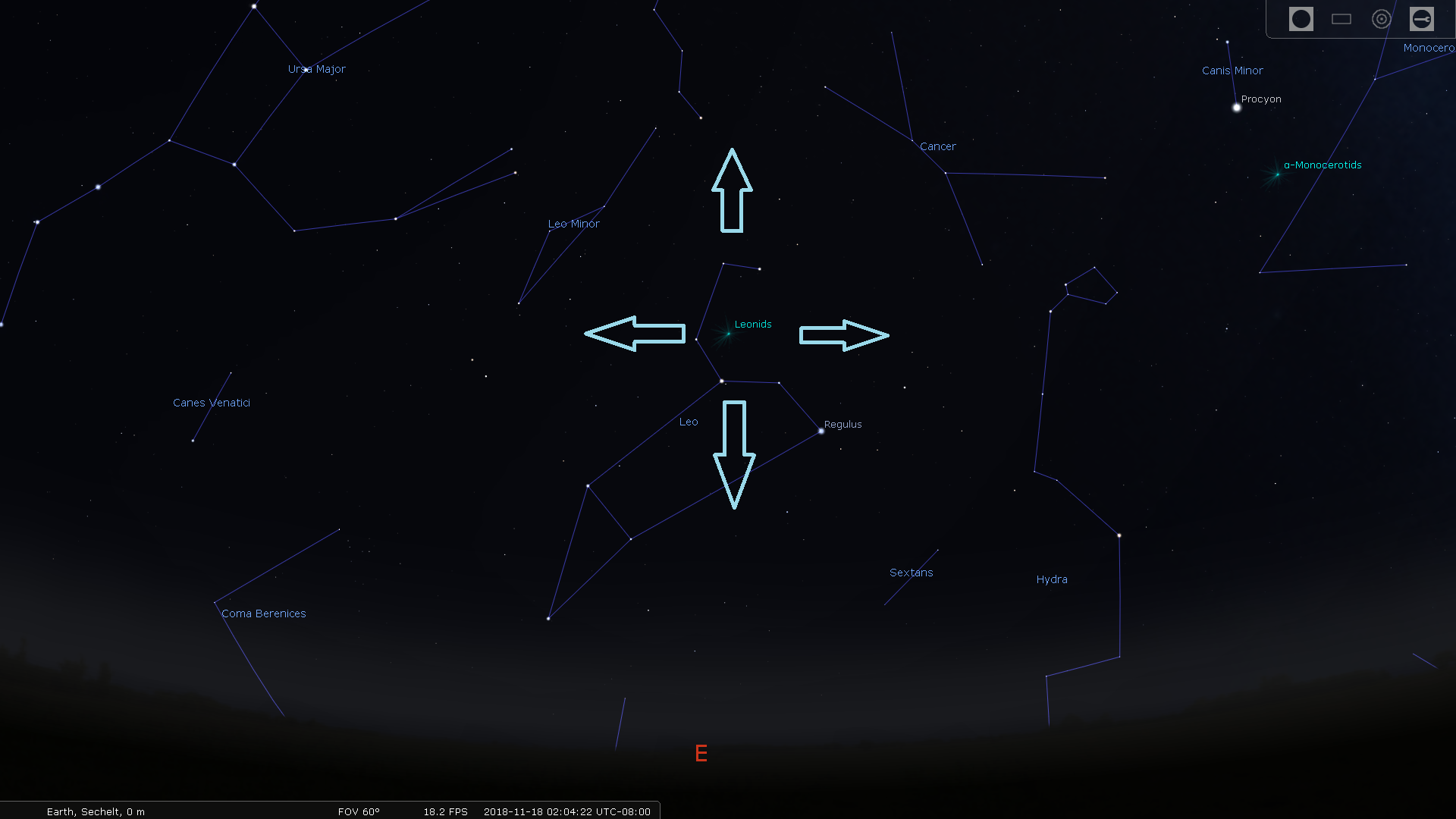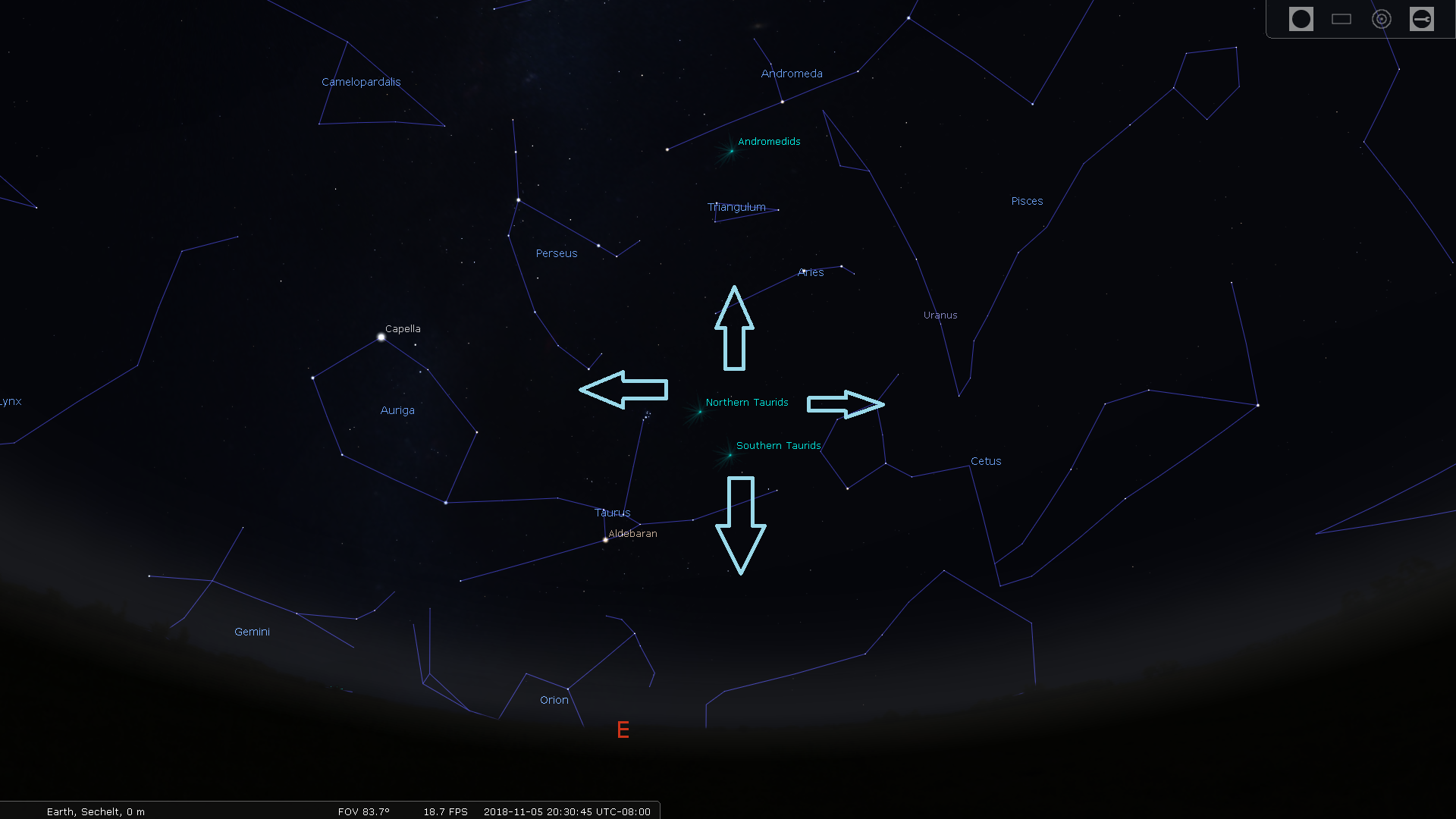Home » Meteors
Category Archives: Meteors
Upcoming Meteor Showers: Taurids and Leonids

There are two Taurid meteor showers:
The Southern Taurids are active until December 8, peaking November 5/6 when the Moon is 44% full. It is caused by the debris field of comet 2P/Encke. Its Zenithal Hourly Rate rarely exceeds 5 meteors/hr. Average velocity 27.7 km/sec.
The Northern Taurids are active until December 2, peaking November 11/12 when the Moon is only 2% full. It is caused by the debris field of comet 2P/Encke. Its Zenithal Hourly Rate rarely exceeds 5 meteors/hr. Average velocity 30 km/sec.

The Leonid shower is active from November 3 to December 2, peaking November 17/18 when the Moon is 23% full. It is caused by the debris field of comet 55P/Tempel-Tuttle. Its Zenithal Hourly Rate is typically 15 meteors/hr. However, it did produce meteor storms in 1833, 1866, 1966, 1999, and 2001. Average velocity 70 km/sec. This comet returns in 2031.
Leonid Meteor Shower: November 17-18

Leo will be in the Eastern sky on the night of 17-18 November.
Every year, between November 6-30, Earth sweeps through a stream of debris left behind by Comet Tempel-Tuttle. The number of meteors increases as the Earth moves deeper into the stream and reaches a peak on the night of the 17th. As the radiant, the point in the sky that the meteors can be traced back to, is inside the constellation Leo, this is called the Leonid meteor shower.
Most meteoroid streams contain only minuscule bits of dust and ice. However, the stream for the Leonids also contains many gravel-sized bits. This produces some very bright meteors in the night sky.
The Leonid meteor shower only produces around 15 meteors per hour, on average. Occasionally, usually shortly after Comet Tempel-Tuttle makes a pass around the Sun, the Leonids can deliver a meteor storm, with hundreds of meteors streaking through the sky every hour. According to experts, such a storm is not expected again until 2033 or 2034.
Leo is rising around 11 pm on the 17th and is fully visible by 2 am on the 17th-18th. The peak of the shower is actually 5 AM on the 17th, so the predawn hours on Saturday are the best viewing time. The Moon is two days past First Quarter on the 17th this year, so there will be some competing light in the sky, which will wash out the faintest meteors. However it will certainly be worthwhile to check the peak out on the 17th. It will definitely be worth it to get out to see the brightest of them, though! Bruce Fryer, Scott Harlow, and I were at the observatory last night and saw a few early arrivals which were quite impressive.
Charles Ennis
Taurid Meteor Showers: 5-6 and 12-13 November
 There are two Taurid meteor showers: Northern and Southern. This is because they originate from the debris left behind by two different objects.
There are two Taurid meteor showers: Northern and Southern. This is because they originate from the debris left behind by two different objects.
- Northern: Asteroid 2004 TG10; and
- Southern: Comet Encke
These two showers overlap into one shower, with two different peaks. Observers note that the meteors in these showers tend to be slower, taking their time to transit the sky, producing some extremely bright bolides. At peak, the Taurids only produce about 5 – 10 meteors per hour. This year the Moon is near new (New Moon on the 7th, First Quarter on the 15th), improving the viewing conditions.
Draconid Meteor Shower: October 8
One can see individual meteors almost any night of the year (known as “sporadics”). However, as the Earth orbits the Sun it repeatedly passes through slender streams of ice, dust and rock, left behind by the passage of comets through the inner solar system. This debris falls into Earth’s upper atmosphere and burns up, a phenomenon we call meteor showers.

The next meteor shower peaks Monday, 2018 October 8: the Draconids. It has this name as the radiant (the place in the sky where meteors will appear to originate) is located in the constellation Draco (the Dragon). This is because the Earth is apparently heading in that direction of Draco at the time of the meteor shower, so the meteors will enter the upper atmosphere and appear to scatter outwards from this point. The Draconids is a minor meteor shower, delivering on average 10 meteors per hour. Viewing conditions are good as this is the day before the New Moon. Hopefully the weather will cooperate!
Charles Ennis, 2nd VP RASC
Perseid Meteor Shower August 12th
Due to inclement weather this event has had to be cancelled.
